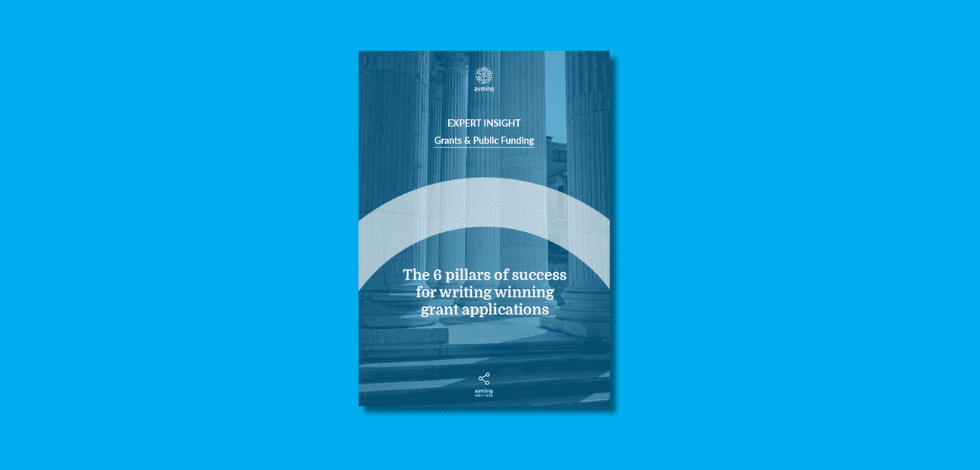Ayming recently submitted a detailed response to the Call for Evidence for the Draft Finance Bill 2022-23. Here Ben Craig, Associate Director of Innovation Incentives, shares an overview of our response to the nine questions asked. If you’d like to read the full response, you can find it on the UK Parliament website.
We wanted to represent the views of our clients of varying sizes and sectors, particularly those who do not have the time or resources to prepare a detailed individual response to the proposed legislation.
We welcome the reform of R&D reliefs, creating an environment where companies can invest in R&D as part of a long-term growth strategy. The key is to ensure that genuine claimants can readily access the reliefs to which they are entitled while restricting the opportunity for error and fraud in the schemes.
Some of the changes planned are positive and bring the schemes up to date for 2023 and beyond.
Others are backward steps, which we think will reduce investment. We also caution against an overreaction to the widely acknowledged problem of error and fraud; if the administrative burden of claiming becomes too difficult, genuine claimants will be deterred from making claims to which they are entitled.
Have the changes to the definition of R&D gone far enough in modernising R&D relief, and if not, what more needs to be included?
We broadly welcome the proposed changes and the inclusion of pure mathematics as qualifying R&D activity. It aligns our scheme with many countries and increases the UK’s competitiveness on the world stage.
It’s a positive step to include data and cloud computing costs, which are often fundamental to R&D, especially for the IT and financial services sectors.
One notable omission is any change to the incentive for capital costs of R&D. The Research and Development Allowances (“RDA”) regime has not been significantly amended since the 1990s, and is of limited appeal, providing few incentives for businesses to invest in capital R&D
There is no proposed change to the treatment of plant hire or premises rental. These types of cost are necessary for many R&D projects but are not currently eligible. This is frustrating for many claimants, and their costs should be included, once again, to align with countries’ R&D schemes.
How effective will the changes be in countering error and fraud resulting from spurious R&D claims and is there more that can be done, or different approaches that could be adopted?
There are very few changes in the proposed legislation that will have any effect on error and fraud.
The legislation proposes to empower HMRC to introduce secondary legislation regarding “additional information in regard to R&D claims”, which are largely administrative burdens that will not necessarily deter those seeking to abuse the reliefs.
Some of the requirements suggested, specifically the requirement for a claim to be endorsed by a senior officer of the claimant company, replicate existing HMRC powers, which are apparently not used effectively.
We welcome the introduction of a requirement that a company notify HMRC of the name of an adviser involved in preparing the claim, if it is accompanied by effective and targeted compliance activity from HMRC. A number of companies offer poor-quality advice, often without the expectations of professional competence from accredited bodies in the tax profession.
We are also concerned about the broad nature of the powers granted. There is a historically problematic relationship between HMRC and taxpayers relating to R&D reliefs and a widely acknowledged limit in the resources available to HMRC.
As a final observation, it is fundamental to the nature of a volume-based R&D incentive that claims must be simple and straightforward to make. If the administrative burden becomes too great to eliminate error and fraud, we risk genuine claimants being put off from claiming; several companies have already indicated that this may be the case.
How successful is the refocusing of the relief in encouraging activity in the UK without adverse consequences?
In principle, the proposed changes are in line with refocusing the relief towards UK-based R&D activity. Significant unintended and negative consequences appear not to have been considered, though.
A significant minority of Ayming’s clients, including one technology ‘unicorn’, incur expenditure on overseas EPWs or subcontractors that the proposed changes would exclude.
However, none of these businesses is planning to onshore any of the activities currently undertaken overseas.
Some companies have accepted that their claims will reduce, which may lead to less overall R&D investment and growth of UK-based revenue. Other companies are actively considering whether to relocate entirely to more favourable jurisdictions; such businesses have historically located their headquarters in the UK due to the favourable treatments available but are now questioning whether that is a good long-term strategy.
How aware are smaller businesses of R&D relief? Is there more that HMRC could be doing in practice to help smaller businesses access relief to which they are entitled?
Relatively few small businesses are aware of R&D reliefs unless approached and informed by tax advisors and accountants, a view supported by HMRC’s own report.
This report also identified that many businesses missed out on claiming R&D relief in previous financial periods through a lack of awareness.
We are even more concerned that very few small businesses are aware of the proposed changes, and the impact that these might have on their claims. Not one of Ayming’s SME clients was aware of any proposed changes until we spoke to them.
There is a clear opportunity for HMRC to be proactive, and to communicate all proposed changes with existing claimants.
How helpful is HMRC and DSIT (formerly BEIS) guidance in interpreting and applying the R&D relief rules?
The guidance provided by HMRC in its manual is useful but is primarily intended for HMRC internal use rather than by companies. The result is that the guidance is often unfriendly for those not familiar with the basic principles of R&D reliefs. The exception to this is the simple guide for SMEs, which we have seen particularly well received by the smallest businesses.
Beyond the published manuals, there is relatively little guidance available. HMRC’s R&D reliefs helpline is often unresponsive, and the response we have found in all cases has been either reference to the CIRD manual, or advice to submit a claim and allow HMRC to review it. This doesn’t help in making accurate claims and is an inefficient use of HMRC resources.
The experience of larger businesses who engage with HMRC’s Large Business Service is mixed, often dependent on the inspector. Some have found productive engagement, with useful pre-claim discussions generating confidence from both HMRC and taxpayers that the claim is correct, and a clear understanding of what documentation will be provided and in what format.
Other companies have found the experience vague with HMRC being non-committal and are now in the position that an enquiry is expected into every claim made; the result is frustration and mistrust from all concerned.
What view do you take of the requirement to give advance notification of R&D claims? What effect would you expect it to have on genuine and spurious R&D claims respectively?
This seems to be an administrative burden that might restrict legitimate claims while having a limited effect on preventing error and fraud.
The exemption for companies having made a claim in any of the previous three accounting periods is welcome since it reduces a company’s admin burden on those which routinely claim.
However, any companies which already make erroneous or fraudulent claims will not be exempted, and therefore this measure will have no effect whatsoever on error and fraud in this circumstance.
For companies which make an occasional, or their first claim, it’s possible that they won’t make a notification, either through omission or being unaware of the requirement.
Genuine claimants may potentially lose out on a claim for a purely administrative reason rather than because they had not invested in R&D. Meanwhile, a company seeking to abuse the scheme seems less likely to omit this step. The measure seems unlikely to have the desired effect.
What is your experience of HMRC’s approach to dealing with claims to R&D relief which it suspects to be invalid, either through misunderstanding of the rules, or fraud?
Ayming has managed HMRC enquiries on behalf of clients across sectors, ranging in size from only a few thousand pounds to multi-million-pound claims. We have also supported clients who have recently received letters from HMRC’s Fraud Investigation Service (“FIS”). Our experience is limited to that of our own clients, and as a result, we believe HMRC’s suspicions to be unfounded in the cases on which we have worked.
The experience in most enquiries is that HMRC’s approach is adversarial and argumentative. Taxpayers have often felt that the inspectors are working from the presumption that the claim is incorrect, and selectively interpret facts to support that view. Facts and evidence supporting the claim can be ignored or unacknowledged if they do not agree with HMRC’s view.
On other occasions, it appears that HMRC’s inspectors are relatively inexperienced. In some cases, enquiry letters are sent that ask formulaic ‘checklist’ questions, many of which are irrelevant to the claim under enquiry.
Other clients have found HMRC’s questioning to be directionless; requests for “all project information” are common, without appreciation that this may extend to thousands of pages across hundreds of files. The result would be a significant administrative effort to provide this evidence, as well as imposing a huge burden on HMRC’s resources to review.
The general result is to foster an atmosphere of mistrust between taxpayers and HMRC. We would prefer an environment in which taxpayers and HMRC could work collaboratively to ensure that the right amount of tax is collected and, by extension, that the right amount of relief is available.
Are there lessons the UK could learn from the tax systems of other countries about how to encourage R&D?
One of the key trends identified across the Ayming Group international client base is that stability is fundamental to encourage investment in R&D.
France and Canada both have long-running schemes, due to consistency of will across the political spectrum to support R&D, allowing companies to make long-term investment decisions in the certainty of the tax implications.
By contrast, Italy has a scheme which has historically been radically altered with changes in political leadership. And in the USA, the recent experience is that R&D reliefs are not factored into investment decision-making at all due to the lack of a long-running incentive.
How successful are the changes in R&D relief likely to be in encouraging innovation and development?
We welcome expanding the scope of the schemes. The increased benefits allow the relevant companies to reinvest the benefits received in future R&D. But we don’t want new admin burdens for genuine claimants.
The majority of Ayming’s clients regard R&D reliefs as a key part of their future innovation planning for innovation. Many companies use the reliefs to mitigate the risks when undertaking a scientific or technologically challenging project. And to take greater risks than might otherwise be commercially prudent. Clients utilise the benefits from their R&D claims by further reinvesting in new innovation.














